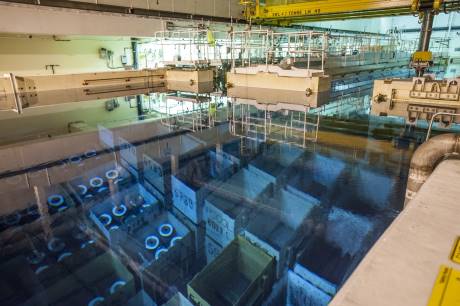Over half the 52,060 used nuclear fuel elements at the former Magnox nuclear power plant at Oldbury in the UK have now been removed from site, two and a half years after the plant generated its last power.
 |
| Oldbury's on-site ponds (Image: NDA) |
Defuelling began at Oldbury in early 2013, and is a key part of the decommissioning process. Fuel is removed from the reactors and then stored in on-site ponds before being transported in flasks to the Sellafield site for reprocessing. To date, nearly 20,000 fuel elements have been shipped from Oldbury to Sellafield.
Around 180 flask shipments will be needed to completely defuel the Oldbury site. Site operator Magnox Ltd hopes to complete defueling in early 2016. Removal of the fuel will also remove over 99% of the site's radiation hazard, Oldbury site director Mike Heaton explained. "We are now focused on removing all the remaining spent fuel from site," he said.
Oldbury unit 1 ceased operation in February 2012, after more than 44 years of commercial operation - unit 2 had closed in June 2011. The two 217 MWe units are owned by the UK's Nuclear Decommissioning Authority (NDA).
Nine of the UK's former Magnox nuclear power plant sites have now been completely defuelled. As well as Oldbury, defuelling is still under way at Calder Hall and at Wylfa unit 2. Partially used nuclear fuel from Wylfa 2, which stopped operating in 2013, is currently being transferred to the still-operating Wylfa 1 which will close by the end of 2015.
Researched and written
by World Nuclear News




_18570.jpg)
_16159.jpg)
_49205.jpg)
_18938.jpg)





